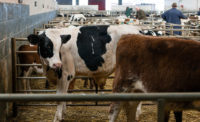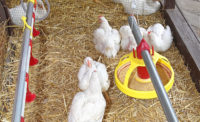Farm to Plate
Data pinpoints need for a continued focus on stunning efficacy and management
A stunning issue: Assessing humane-handling enforcement actions and developing teachable moments for processors on stunning and handling of animals.

In 2016 and 2017, 107 and 104 humane handling enforcement actions were posted to the U.S. Department of Agriculture’s Food Safety and Inspection Service (FSIS) Web site, respectively. A detailed look at the data pinpoints the need for a continued focus on stunning efficacy and management.
Summary
The majority of enforcement actions were documented in cattle facilities (52.4 percent, 49 percent) for 2016 and 2017, respectively. The remaining percentage was composed of swine (37.1 percent, 38.5 percent), sheep (8.6 percent, 6.7 percent) and goats (1.9 percent, 1 percent). In 2017, 5 percent of the letters did not clearly disclose the species of animal involved. Because cattle and swine continue to be the two most common groups of livestock slaughtered for red meat in the United States, the greater proportion of total enforcement actions in beef and pork plants is likely a result of the larger population size. But stunning error remains as the most common cause of FSIS enforcement actions related to the Humane Slaughter Act.
Regulatory choices
The Humane Slaughter Act of 1978 (7 U.S.C. §§ 1901) and the regulations that enforce it (9 CFR 313) provide the framework for regulating the humane handling and stunning of red-meat species. The regulations in 9 CFR 313 can be divided into three primary categories: stunning; handling; and facilities. In 2016, 94.4 percent (101 of 107) enforcement actions were related to stunning and the remaining 5.6 percent (6 of 107) involved handling issues. In 2017, 88.5 percent (92 of 104) enforcement actions pertained to stunning, while 11.5 percent (12 of 104) cited handling problems. No facility-related enforcement actions were issued in 2016 or 2017.
In the event of an alleged violation of 9 CFR 313, FSIS takes one of two primary enforcement actions. The first action is suspension, which ceases inspection services until the observed humane handling issue is suitably addressed. Inspection is reinstated after a response is drafted, reviewed and approved by the district office. The second action is a notice of intended enforcement (NOIE). This action is a warning that acknowledges an infraction that must be addressed but inspection is not suspended. If corrective action is not taken, a NOIE can develop into a suspension. In 2016, 70.1 percent (75 of 107) of enforcement actions were suspensions and 29.9 percent (32 of 107) were NOIEs. In 2017, 58.7 percent (61 of 104) of the enforcement actions were suspensions, 18.3 percent (19 of 104) were NOIEs and 23.1 percent (24 of 104) progressed to reinstatement of suspension.
For 2017, the enforcement actions were categorized differently than in past articles to include additional detail regarding regulatory follow-up actions. The FSIS has three follow-up actions that can be taken after issuing a suspension or NOIE. One follow-up action occurs after the issuance of a suspension, where an abeyance of a suspension can be selected. The second option is a reinstatement of suspension, which occurs when corrective actions were insufficient or another violation has occurred. The third follow-up action is a letter of deferral that can occur after the issuance of a NOIE. Abeyances and deferrals are selected when the establishment has shown the appropriate corrective action and preventive measures have been taken. Under a deferral, an establishment’s previously issued NOIE does not progress to a suspension. An abeyance ceases the progression of an ongoing suspension for an establishment. In 2017, 81 percent of enforcement actions proceeded to abeyances, while the remaining 19 percent progressed to deferrals. (Note: Four enforcement action follow-ups were unaccounted for within the 104 total letters in 2017.) After follow-up action, the FSIS still reserves the right to reinstate suspension for establishments that do not appropriately address the identified issue or issues.
Handling
In 2016, there were six handling-related enforcement actions. There were 12 in 2017. Abusive handling by livestock transporters was the cause of four of the six violations in 2016 and five of the 12 in 2017. The event of unloading falls under the responsibility of the plant’s management, including the assignment of either company personnel or truckers to perform the unloading. The establishment takes full responsibility for the animals once the trailer is in line to unload at a slaughter facility. Improper handling — which involves excessive electric prod use and electric prod use on sensitive areas, kicking, hitting and misuse of handling aids and other tools such as PVC pipe and sticks — is regarded as abusive and must not be allowed. Sensitive areas include genital areas and any facial region, such as eyes, ears and nose. The types of handling events that resulted in enforcement actions in 2016 and 2017 fit the description of “willful acts of abuse” in the North American Meat Institute’s Recommended Animal Handling Guidelines and Audit Guide. The NAMI’s publication is the guiding document for the majority of humane handling and stunning auditing programs in North America.
One of the six handling-related incidents included improper treatment of downer or non-ambulatory animals in 2016. In 2017, eight of the 12 incidents involved downers. The 2016 violation involved dragging and pushing conscious animals off the backs of trailers and allowing animals to trample a downed animal. There were four incidents in 2017 that involved ambulatory animals. Three of these were related to aggressively hitting or kicking animals, and the last involved an electric prod that was applied to the nose of a hog.
In 2017, one specific handling-related enforcement action underscored the importance of taking prompt action when nonambulatory animals are identified. The report indicated an inspector informed a plant employee that there were two downed cows that needed to be euthanized. The plant employee took 15 minutes to respond and one of the cows died during that time. Non-ambulatory animals must either be euthanized immediately to end suffering or appropriately moved to a suspect pen to recover. Identifying the cause of an animal’s non-ambulatory state is critical to the process of deciding between movement to a suspect pen or applying appropriate euthanasia. Oftentimes, cattle are euthanized on the spot, whereas other species, such as pigs, lambs, sheep and goats may be moved to a suspect pen. A conscious animal can never be dragged. A suitable sled, handcart or stretcher must be used to transport the animal. A properly stunned or euthanized animal may be dragged without issue.
Stunning
Stunning-related incidents accounted for 94.4 percent (101 of 107) of enforcement actions in 2016 and 88.5 percent (92 of 104) in 2017. In 2016, 87 percent of the stunning-related enforcement actions involved the use of mechanical stunning methods, including firearms and captive bolt guns. Electrical stunning (8 percent) and ritual slaughter (5 percent) incidents were less common. The distribution of stunning-related enforcement actions was similar in 2017 as 88.3 percent involved mechanical stunning methods; 8.5 percent, electrical stunning; and 2.1 percent, ritual slaughter. One stunning-related enforcement action cited the use of mechanical followed by electrical stunning. In 2017, we categorized the stunning methods in greater detail to assist in understanding the distribution of stunning-related enforcement actions between firearm and captive bolt methods. Captive bolt stunning was involved in 61.5 percent (51 of 83) of all mechanical stunning enforcement actions, while firearm-related incidents represented 38.5 percent (32 of 83). The 2017 stunning-related enforcement actions were also classified by incident cause during our assessment. Incorrect placement of the stun was the major cause of reported incidents (70.3 percent; 64 of 91), followed by improper restraint (23.1 percent; 21 of 91) and equipment issues (6.6 percent; 6 of 91).
In 2016, five enforcement actions detailed ineffective ritual slaughter procedures. Two of those cases resulted in mechanical stunning assistance after an ineffective ritual procedure while the other three cases resulted in the animal moving freely around the slaughter floor after being released or escaping restraint. Two ritual slaughter enforcement actions were reported in 2017; one case involved mechanical stunning assistance following an ineffective ritual procedure and the other case involved the need of a second ritual cut as the cattle were still conscious in both cases. Precise ritual cut placement and animal restraint are key to an effective ritual slaughter procedure. It is important to have an emergency stunning method quickly available in ritual slaughter operations to prevent suffering in situations where animals do not rapidly lose consciousness.
Appropriate action
In 2016 and 2017, ineffective stunning was the leading cause of FSIS enforcement actions related to the Humane Slaughter Act. In 2017, stun placement error was identified as the primary cause for ineffective stunning. Stun placement can be improved through the use of effective training in many cases. One tip that helps improve stun placement training is to split a few heads from previously slaughtered animals to observe the location of the brain. The stunner operator may find that a mental image of brain location helps to maintain accurate stun placement. It is also important to assess the ergonomics of the stunning operation. A common cause of stun placement problems is awkward body or stunner positioning at the stunning location. Restraint plays a role in stun placement as well. Animals that are well restrained are less likely to move at the moment of stunning so long as the restraint does not cause the animal to struggle.
The best way to avoid Humane Slaughter Act enforcement action is to prevent it. A robust Systematic Approach to Animal Welfare should provide data to assist in troubleshooting animal handling and stunning operations. It is important to evaluate handling and stunning operations with a risk-focused approach. As you assess your stunning and handling system, regularly ask these two questions: 1) What risks exist here? and 2) How can we reasonably minimize those risks? NP
Faith Baier is a master’s student and graduate research/teaching assistant under Temple Grandin, Ph.D., at Colorado State University studying livestock behavior and welfare. Lucas Heimmermann is an animal science undergraduate student at the University of Wisconsin River-Falls and will be attending the University of Wisconsin-Madison School of Veterinary Medicine in the fall. Sara Odegard is a master’s student studying Agricultural Education with an Animal Welfare emphasis at the University of Wisconsin-River Falls. Kaleiah Schiller is a graduate research assistant at the University of California-Davis.
Kurt Vogel, Ph.D., is an assistant professor in the Animal and Food Science Department at the University of Wisconsin-River Falls. He is also president of Vogel Livestock Solutions, a food animal welfare consulting company. If you have any questions or comments, contact Vogel by email: kurt.vogel@uwrf.edu or phone: (715) 425-4704.
Looking for a reprint of this article?
From high-res PDFs to custom plaques, order your copy today!






